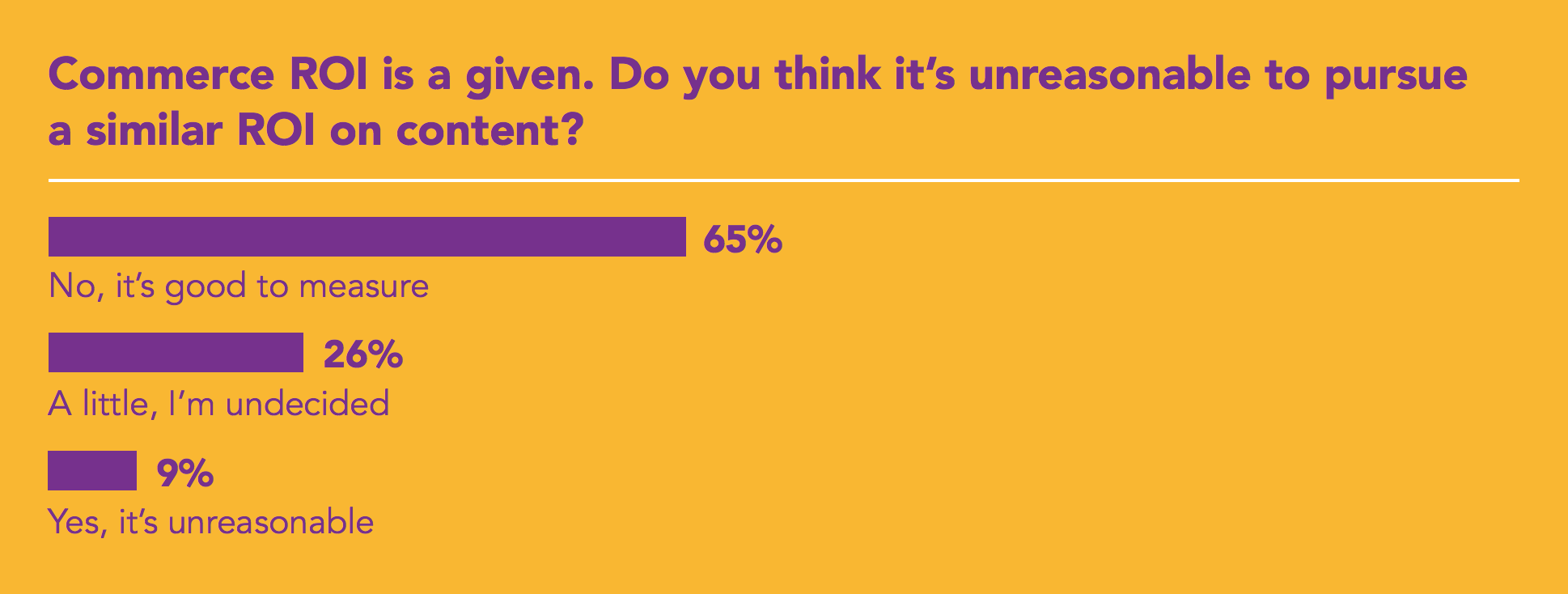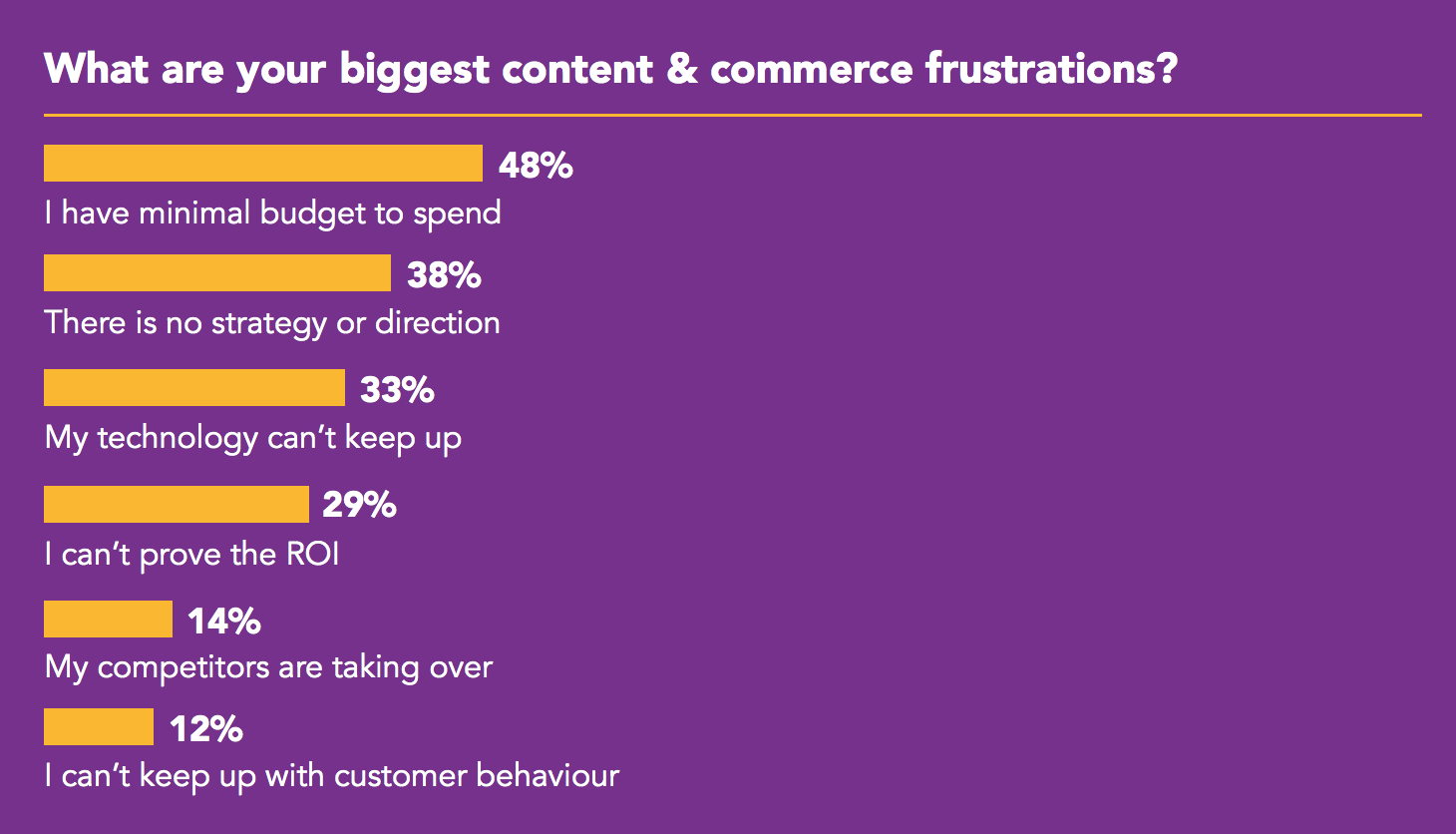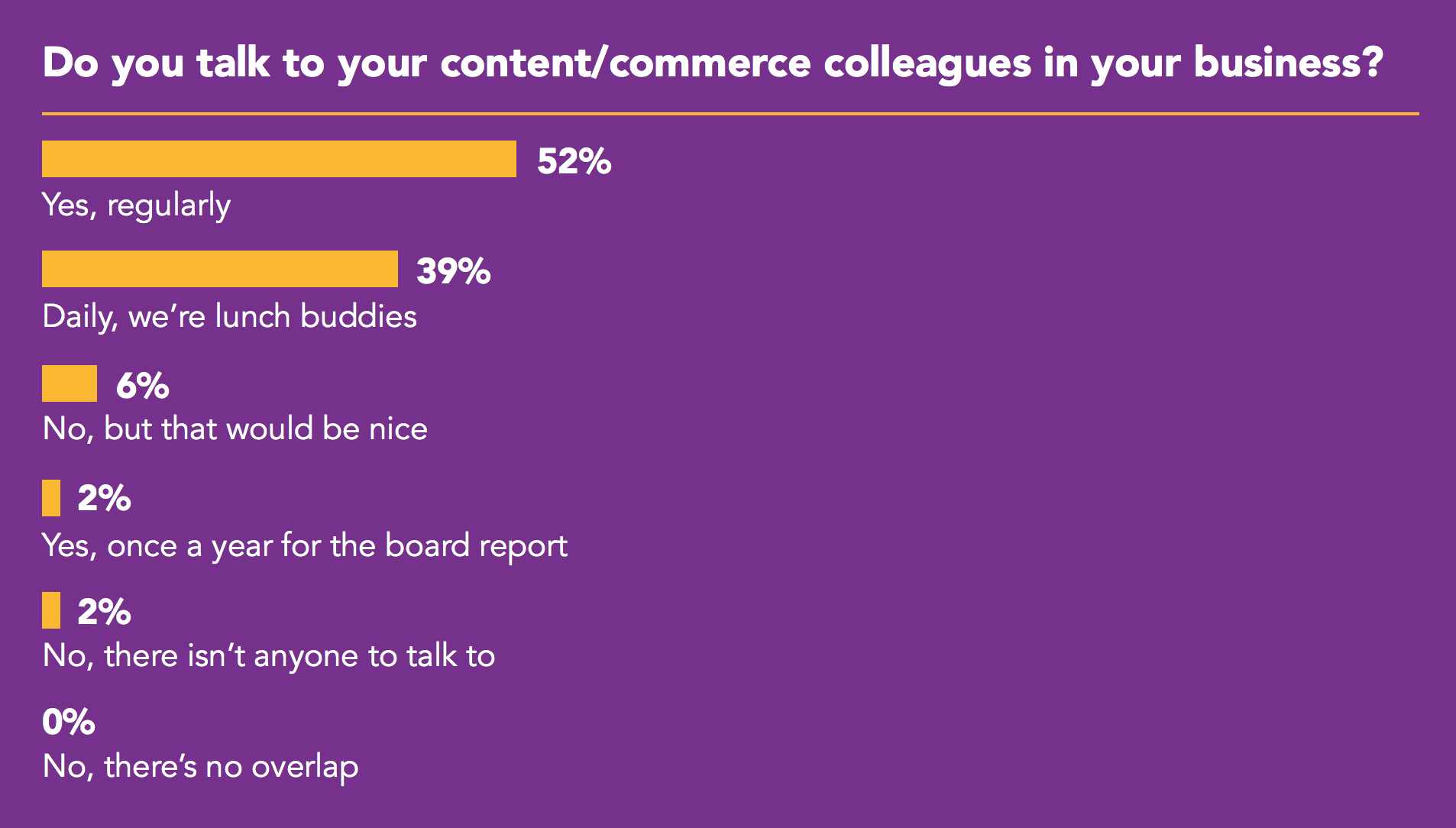Content for commerce: bringing commerce to life with engaging content
Content and commerce are two words that are perhaps more closely aligned with the digital era than any others. But for an industry that’s been successfully selling online for decades, it’s astounding that there’s only recently been a real push for using content to drive and measure retail sales online. Content for commerce is now a thing.
Today, every retailer has a story to tell, a picture to share, and a video to show. The problem is that content isn’t a natural partner of commerce – in either technological or business terms.
Content and commerce teams each tell a familiar story in which marketing and ecommerce personnel operate in silos with differing objectives. While content has traditionally sat within marketing, ecommerce is intrinsically linked to the traditional sales cycle and supply chain.
This naturally leads each group to buy and operate independent solutions for brand content and transactions. In many ways, these two are the archetypal odd couple. Indeed, the industry hasn’t even agreed on a name for their marriage.
At a Commerce Futures event, Joel Freeman, co-founder of Grabble, referred to the joining of content and commerce as ‘content commerce’. Some call it ‘Content 4 Commerce’, while others still refer to it as ‘measuring ROI from content marketing’.
One thing’s clear: in an age where consumers can get almost anything they want from websites like Amazon – not to mention have it delivered the same day – content is fast becoming a weapon that brands rely on to keep their customers coming back. Now more than ever, companies need cohesive digital customer experiences. And now more than ever, today’s marketers need to tell brand and product stories with the depth of personalisation and contextualisation that only content can provide.
The good news is that businesses understand that revenue is generated by both content and commerce. We surveyed 80 content and commerce professionals for their views, and found that a majority (59 percent) believe their business is both content and commerce driven.

And this trend is here to stay. Almost all (98 percent) of the people surveyed think this is a long-lasting development in the industry. The following report will illustrate the benefits of a combined content and commerce strategy, but question how ready brands really are to take a ‘content for commerce’ approach.
Today’s marketers need to tell brand and product stories with the depth of personalisation and contextualisation that only content can provide.
Trumpet blowing
The industry understands the importance of content for commerce, and some brands are getting it really right.
A successful content for commerce approach drives return on investment (ROI), and the need to measure ROI against content is beginning to be recognised by the industry. This is evident in our study which found that almost two-thirds (65 percent) believe it is good practice to measure ROI on content, although a quarter (26 percent) said they are still undecided.

Successful content for commerce strategies are engaging
Companies are realising the benefits of content-driven commerce websites. Much more than simply having a catalogue of products listed on a website, this means creating content around the ecommerce proposition to tell stories, engage consumers, and encourage them to take an action such as sharing content with their peers.
The cosmetics company Lush, for example, launched a new website in 2014, aiming to truly draw in the customer. Instead of looking like an ecommerce site that happens to be branded ‘Lush’, this website’s intelligent visuals make it truly engaging. Every Lush product page has a hero video where a product is taken out of its packaging so customers can get an online sensory experience that mimics the tactile experience of being in a physical store. This also doubles as a user guide, showing the customer exactly how the product can be used.
The benefits of a content for commerce strategy are clear for the Lush website. Within the first 18 months of launching the site, the company experienced a 64 percent increase in digital orders, 75 percent increase in website sessions, and a 16 percent decrease in abandoned shopping carts.
Described by Econsultancy as a ‘website that happens to sell stuff, too’ Lush has been credited ‘the undisputed master of branded commerce’.
Another example of a brand that’s had huge success in contentdriven commerce is Apple, whose magic formula is based around the understanding that building relationships is the secret to selling more products. Apple has brought the magic of its technology to life on its website through content that tells customers a story about each product, inviting visitors to learn, explore and watch, as well as buy.
Puma has also felt the benefits of revenue growth as a result of a unified content and commerce strategy. Since implementing its strategy, the company has seen increased mobile purchases from 1.6 to 3.4 percent. Chris Hardisty, general manager and head of ecommerce at Puma, commented on the benefits to the customer experience: ‘Prior to this launch, we had a brand site and a regionalised shopping site. It wasn’t what you’d call a unified experience for the customer’.
Personalisation is key
In what Forrester has labelled the ‘Age of the Customer’, the way that customers interact with organisations has fundamentally changed, and customer expectations have grown accordingly. These increased expectations lead to increased marketing challenges as customers choose to interact with companies across more and more channels – such as mobile and social – and firms struggle to manage and utilise the wealth of customer data available today.
In this context, personalisation is critical for marketers seeking to enhance customer centricity and engagement. It’s little surprise then that the overwhelming majority (70 percent) of content and commerce professionals see personalisation as ‘great if you can do it’, according to our research.
When it comes to personalisation, Currys struck the right chord in its 2015 Christmas campaign when it invited customers to complete an online entry form on its website. The form asked customers what they would like for Christmas and where they would like their ‘subtle present hint’ to appear. The retailer then streamed customised hints across 500 outdoor sites, as well as paid social and radio adverts. Crucially, the hints were personal and contextually relevant.
Sofa.com is another company that has reaped the benefits of personalised content on its website, with a section for customers to upload pictures of their sofas in their homes. By creating an experience that engages customers, the company has put the control over content in the hands of consumers, which has the effect of driving loyalty
The University of Cambridge’s Psychometrics Centre is also making exciting advancements in personalisation. As Vesselin Popov, the Centre’s business development director, explained: ‘people spend more money on things that fit their profile – and this makes them happy’. Brands understand this, he explained, noting that 94 percent of CMOs say it’s important to understand the psychological attributes of their customers.
But putting this into practice isn’t always easy, which is why the department has developed an API to help build a more personalised internet. The department is making computer-based judgements about consumer personalities based on digital footprints – in other words, what a consumer likes, does and says online.
People spend more money on things that fit their profile – and this makes them happy. Brands understand this: 94% of CMOs say it’s important to understand the psychological attributes of their customers.
From trumpet blowing to whistle blowing
Although some brands are getting content and commerce right, others experience major challenges when putting strategies in place. One explanation for this might be that consumers don’t necessarily want to take their wallets out when they’re in reading mode, absorbing content online, and learning about products before purchase. It’s hard to create authentic content that also serves business goals.
Holistic customer experience
That’s why content needs to enhance and enable the complete customer journey – from initial engagement, through to sale, and then to after-sale care and customer retention. And there are several phases along the way.
Google industry manager Rebecca Gay described these customer journey phases as: ‘I want to watch, I want to know, I want to find and I want to buy’, adding that the path from ‘I want to watch’ to ‘I want to buy’ is ‘insanely complicated, and those that get it right are combining data insights with content effectively’. The different phases are reliant on different types of content. If brands want to target consumers in the research phase, content needs to include the right keywords, and if brands want to build awareness, their content should be inspirational.
Content also has to be intuitive and fast. As Gay explained, the founding principle of Google is that ‘fast is better than slow’, with 57 percent of us abandoning a web page that takes more than three seconds to load.
So the content not only has to be relevant and engaging, it also has to tick the right performance boxes. If it doesn’t, there will be very little ROI to measure at all. Worryingly, content and commerce professionals told us that only 7 percent of brands are exceeding customer expectations. Even worse, 25 percent don’t meet customer expectations at all. 2
25% of brands don’t meet customer expectations at all.
Overcoming frustrations when using content for commerce
In assessing the challenges of approaching a content strategy in ecommerce, we set out to find out what people in the industry thought were the main barriers on a day-to-day basis. We found that the biggest content and commerce frustrations are lack of budget (48 percent) and lack of strategy or direction (38 percent). These issues were closely followed by the failure of technology to keep up (33 percent) and inability to prove ROI (29 percent).
Clearly, many of these challenges are directly interrelated, which means that improving one will have an impact on others. For example, larger budgets can improve the performance of technology, and better strategy will lead to improved ROI.
 Another significant challenge for the industry is finding a way to break down the silos that exist between and content and commerce teams. This is certainly a frustration that was highlighted in our study of industry professionals. We found that only 52 percent regularly speak to each other and one-in-ten businesses don’t have content and commerce departments that talk regularly at all.
Another significant challenge for the industry is finding a way to break down the silos that exist between and content and commerce teams. This is certainly a frustration that was highlighted in our study of industry professionals. We found that only 52 percent regularly speak to each other and one-in-ten businesses don’t have content and commerce departments that talk regularly at all.
Overcoming these frustrations isn’t easy, but brands are increasingly breaking down the divide between traditional departments to make this happen. For example, this is something that Lush has been really successful at with the creation of a new part of the company dedicated to bringing together all stakeholders of the digital revolution under one roof – including ecommerce, content, customer services and development.

Your digital commerce site is built to sell, but your content is essential if you are to add value to your products online and compel customers to spend. Without the right content, your website may be just a collection of bland promotional images.
Putting a strategy in place, with KPIs and business goals, is essential for brands that want to get it right. The ability to measure outcomes against these goals is also vital if brands are to track the progress of their content for commerce approach.
So how do you achieve this balance?
In order to enrich your commerce site you will need a flexible content management repository, like Drupal 8 or eZ Platform, that will set you up for multichannel content delivery and can easily create and extend content types to meet your specific business needs, and crucially structure your content.
This approach will enable your organisation to deliver your content not only to your commerce site, but across a myriad of channels, devices, apps and platforms, as well as consume content from third-party sources like social media, and push it to any site, app or channel.
We are in an age of connected systems where the emphasis is on using the best available of each component to meet a particular business goal – and then ensuring these systems talk to each other effectively. Gone are the days of needing to try and wrestle everything from a single system as we have had to do in the not-so-distant past.
The latest iteration of major ecommerce platforms from the likes of Magento, and new entrants like Spryker, have recognised this shift to connected systems. Both these platforms provide modules, connectors, and direct API access enabling organisations to deliver a unified and seamless content-commerce user experience.
Taking this approach allows each part of the system to play to its strengths – for example, allowing ecommerce frameworks to handle the transactional areas of the site and the CMS to provide the flexible editor experience a brand requires.
Key investment decisions
Making these decisions isn’t easy. And that’s why businesses are in need of the right people, with the right skillset. Our study found that a majority (57 percent) of professionals think people and skills are a key investment priority over the next 12 months. Having the right technology (55 percent) and data analytics (67 percent) in place is also key.
With innovative new technologies emerging, it’s clear that brands are increasingly looking to adopt the latest content technology to engage with their target market in new and exciting ways, aid findability, and acquire visitors. Almost two-thirds (62 percent) are looking forward to implementing hyper-contextualisation technologies, with virtual reality (16 percent), conversational commerce (10 percent) and invisible payments (10 percent) further down the priority list.
Opportunity knocks
The current maturity of the online world is presenting brands with an opportunity like never before – the chance to use the best available tools to meet the needs of the customer. Brands no longer have to select a system as a compromise and accept its shortcomings. And they no longer have to separate the online content they present from the sales that they reap.
Bridging the gap between content and commerce can bring rich content experiences to customers, allowing forward-thinking brands to engage with their customers more effectively, and on a more personable level than ever before.
So to all the commerce experts out there, I say: it’s time to be more than just lunch buddies with your content colleagues.





